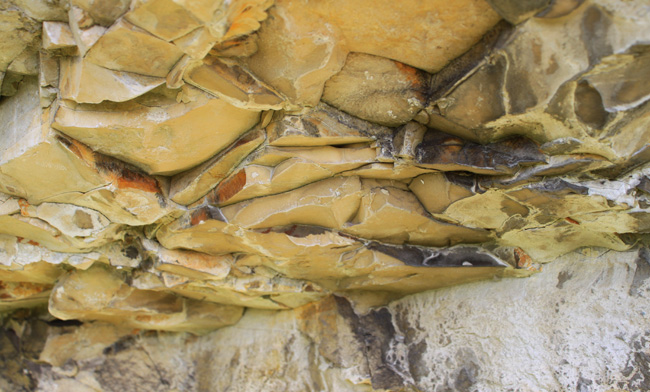Be smart, be an EarthCacher - geology rulez! ;)

Acknowledgment: Monika Krzeczyńska MSc / Polish Geological Institute-National Research Institute
Podziękowanie: mgr Monika Krzeczyńska / Państwowy Instytut Geologiczny-Państwowy Instytut Badawczy

Kamieniołom położony jest u stóp jednego z wyraźnych wzniesień jurajskich Jury Polskiej ciągnącej się długim pasem od Krakowa do Częstochowy. Są to wzniesienia, których trzonem są wapienie skaliste powstałe z gąbkowo-sinicowych struktur - tzw. bioherm, które rozwijały się na dnie głębokiego morza jurajskiego tworząc rozległe budowle osiągające rozciągłość do kilkunastu kilometrów i wysokość kilkuset metrów.

Ławica wapieni pelitowych / photo & background photo: hanbei
W kamieniołomie zaobserwujemy dwa rodzaje wapieni: wapienie pelitowe o stosunkowo jednorodnej drobnoziarnistej strukturze (zdjęcie w listingu) oraz położone nad nimi wapienie, w których można rozpoznać fragmenty ostrokrawędzistych bloków i okruchów skalnych różnej wielkości. Wyraźnie widoczna jest również granica między nimi (przebiega wzdłuż niskiej "przewieszki")
Jak wytłumaczyć taką zmienność w budowie sąsiadujących ze sobą bezpośrednio skał? kamieniołom położony jest w obrębie tzw. basenu międzybiohermalnego u stóp bogatego w faunę zespołu biohermalnego. W wyniku podwodnych ruchów masowych (obrywu -osuwiska) nastąpiło zsunięcie dużej masy wapieni po stromych stokach biohermy do jej podstawy. W trakcie ruchu materiał został rozbity na różnej wielkości bloki i okruchy. Dzisiaj tworzy zwartą lecz wewnętrznie niejednorodną skałę, która przykrywa powstałe w tym miejscu wczesniej drobnoziarniste wapienie pelitowe.
Odpowiedzi proszę wysyłać za pomocą mojego profilu. Nie trzeba czekać na moją odpowiedź, można od razu logować. Jeśli coś będzie nie tak, zgłoszę się sam. Pamiętajcie proszę, że logi bez podesłanych odpowiedzi będą kasowane.
ZADANIA
- Określ grubość ławicy wapieni pelitowych znajdującej się bezpośrednio pod wapieniami pochodzącymi z osuwiska
- Jak nazywa się skała okruchowa składająca się z ostrokrawędzistych fragmentów innych skał scementowanych spoiwem w tym przypadku wapiennym – czyliskała, którą obserwujemy w kamieniołomie ponad warstwą wapieni pelitowych?
- Zadanie opcjonalne: możecie zrobić tu piknik, przerwę, ale i zdjęcie ;)

“Amerykan” Quarry
The quarry is located at the foot of one of the hills belonging to Polish Jura, in area that goes from Krakow to Czestochowa. The core of the hills are made of rocky limestone formed from sponge-cyanobacterial structures - so called. bioherms which developed at the bottom of the deep seafloor, reaching up to few kilometers in width and a height of several hundred meters. In the quarry you can observe two kinds of limestones: pelitic that are rather finegrained and homogenous, as well as laying above them limestones that include sharp blocks and rock fragments of different sizes. The boundary between them is clear and runs along visible overhang. How to explain such variability in the rocks that are so close to each other? The quarry is located in so called biohermal basin right at the foot of rich in fauna biohermal elevation. As a result of underwater mass movement of sediments a huge amounts of limestones slided downslope to its base. During the slide the material was crushed into smaller blocks and fragments. Today they form a compact but heterogeneous structure covering older pelitic limestones that developed here previously.
You can send answers via my profile. You do not need to wait for my answer, you can log instantly. If something is wrong I will contact you myself. Please remember that logs without answers will be deleted.
TASKS
- Determine the thickness of politic limestone layers located directly beneath the limestone derived from landslide.
- What is the name of a clastic rock consisting of sharp-edged fragments of other rocks cemented carbonate binder – the rock we have seen in the quarry above the layer of politic limestone?
- Optional: you can do a picnic here, take a break, or a picture;)
